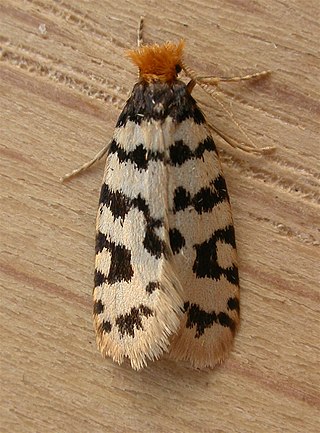
The Psychidae are a family of the Lepidoptera. The bagworm family is fairly small, with about 1,350 species described. Bagworm species are found globally, with some, such as the snailcase bagworm, in modern times settling continents where they are not native.

The Sphingidae are a family of moths commonly called sphinx moths, also colloquially known as hawk moths, with many of their caterpillars known as "hornworms"; it includes about 1,450 species. It is best represented in the tropics, but species are found in every region. They are moderate to large in size and are distinguished among moths for their agile and sustained flying ability, similar enough to that of hummingbirds as to be reliably mistaken for them. Their narrow wings and streamlined abdomens are adaptations for rapid flight. The family was named by French zoologist Pierre André Latreille in 1802.

A pupa is the life stage of some insects undergoing transformation between immature and mature stages. Insects that go through a pupal stage are holometabolous: they go through four distinct stages in their life cycle, the stages thereof being egg, larva, pupa, and imago. The processes of entering and completing the pupal stage are controlled by the insect's hormones, especially juvenile hormone, prothoracicotropic hormone, and ecdysone. The act of becoming a pupa is called pupation, and the act of emerging from the pupal case is called eclosion or emergence.

The small heath is a butterfly species belonging to the family Nymphalidae, classified within the subfamily Satyrinae. It is the smallest butterfly in this subfamily. The small heath is diurnal and flies with a noticeable fluttering flight pattern near the ground. It rests with closed wings when not in flight. It is widespread in colonies throughout the grasslands of Eurasia and north-western Africa, preferring drier habitats than other Coenonympha, such as salt marshes, alpine meadows, wetlands, and grasslands near water. However, habitat loss caused by human activities has led to a decline in populations in some locations.

The silver-studded blue is a butterfly in the family Lycaenidae. It has bright blue wings rimmed in black with white edges and silver spots on its hindwings, lending it the name of the silver-studded blue. P. argus can be found across Europe and east across the Palearctic, but it is most often studied in the United Kingdom where the species has experienced a severe decline in population due to habitat loss and fragmentation.

Hyalophora cecropia, the cecropia moth, is North America's largest native moth. It is a member of the family Saturniidae, or giant silk moths. Females have been documented with a wingspan of five to seven inches or more. These moths can be found all across North America as far west as Washington and north into the majority of Canadian provinces. Cecropia moth larvae are most commonly found on maple trees, but they have also been found on cherry and birch trees among many others. The species was first described by Carl Linnaeus in his 1758 10th edition of Systema Naturae.
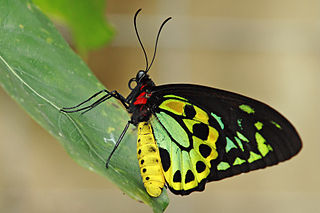
Ornithoptera euphorion, the Cairns birdwing, is a species of birdwing butterfly endemic to Queensland, and is Australia's largest endemic butterfly species. Other common names include Cooktown birdwing and northern birdwing. The names Cairns and Cooktown in its common name reference the Australian cities in the region where this butterfly is found.

Lucanus cervus, known as the European stag beetle, or the greater stag beetle, is one of the best-known species of stag beetle in Western Europe, and is the eponymous example of the genus. L. cervus is listed as Near Threatened by the IUCN Red List.
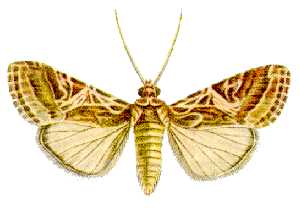
Spodoptera litura, otherwise known as the tobacco cutworm or cotton leafworm, is a nocturnal moth in the family Noctuidae. S. litura is a serious polyphagous pest in Asia, Oceania, and the Indian subcontinent that was first described by Johan Christian Fabricius in 1775. Its common names reference two of the most frequent host plants of the moth. In total, 87 species of host plants that are infested by S. litura are of economic importance. The species parasitize the plants through the larvae vigorous eating patterns, oftentimes leaving the leaves completely destroyed. The moth's effects are quite disastrous, destroying economically important agricultural crops and decreasing yield in some plants completely. Their potential impact on the many different cultivated crops, and subsequently the local agricultural economy, has led to serious efforts to control the pests.
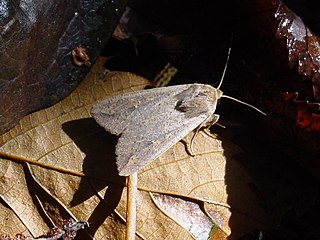
Mythimna unipuncta, the true armyworm moth, white-speck moth, common armyworm, or rice armyworm, is a species of moth in the family Noctuidae. The species was first described by Adrian Hardy Haworth in 1809. Mythimna unipuncta occurs in most of North America south of the Arctic, as well as parts of South America, Europe, Africa, and Asia. Although thought to be Neotropical in origin, it has been introduced elsewhere, and is often regarded as an agricultural pest. They are known as armyworms because the caterpillars move in lines as a massive group, like an army, from field to field, damaging crops.
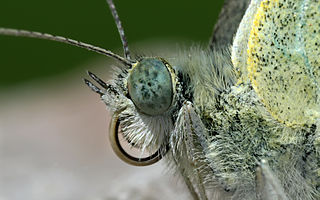
The external morphology of Lepidoptera is the physiological structure of the bodies of insects belonging to the order Lepidoptera, also known as butterflies and moths. Lepidoptera are distinguished from other orders by the presence of scales on the external parts of the body and appendages, especially the wings. Butterflies and moths vary in size from microlepidoptera only a few millimetres long, to a wingspan of many inches such as the Atlas moth. Comprising over 160,000 described species, the Lepidoptera possess variations of the basic body structure which has evolved to gain advantages in adaptation and distribution.

Xeris spectrum is a kind of horntail or wood wasp, that lives in coniferous forests. It is large wasp with a powerful ovipositor in females. Unlike other Siricid Wood wasps, Xeris spectrum does not have symbiotic fungi to aid its larvae as they burrow in the wood of fir and other conifer trees making it unique in the Siricidae. It is widespread and is found in large parts of Europe, Asia, Africa and North America.
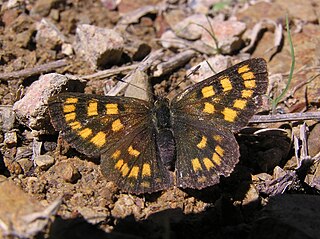
Lycaena feredayi, the glade copper, is a butterfly of the family Lycaenidae. It is endemic to New Zealand.
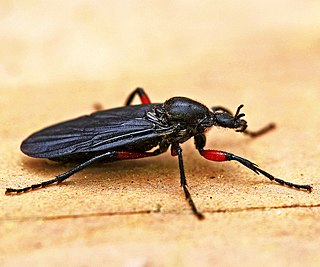
Bibio femoratus, also known as the March fly or lovebug, is a species of fly in the family Bibionidae. It was first described by the German entomologist Christian Rudolph Wilhelm Wiedemann in 1820.Bibio femoratus is one of at least 90 types of March flies, which occur in the United States and Canada.

Dryomyza anilis is a common fly from the family Dryomyzidae. The fly is found through various areas in the Northern hemisphere and has brown and orange coloration with distinctive large red eyes. The life span of the fly is not known, but laboratory-reared males can live 28–178 days. D. anilis has recently been placed back in the genus Dryomyza, of which it is the type species. Dryomyzidae were previously part of Sciomyzidae but are now considered a separate family with two subfamilies.

Macrotera portalis is a species of communal, ground nesting, partially bivoltine bees found in arid grasslands and desert regions of North America. An oligolectic bee, M. portalis gathers pollen only from plants in the genus Sphaeralcea and has patterns of seasonal emergence to survive the harsh conditions of the desert, with emergence delayed until monsoon rains arrive.

Camponotus castaneus, the red hazelnut carpenter ant, is a species of carpenter ant located in the eastern United States. It is a primarily orangish-red ant in the family Camponotus. Its workers are usually around 8-10 mm, and queens around 18-20 mm. As with most Camponotus species, camponotus castaneus has majors and super-majors, usually appearing in the second or third year of the colony's founding, majors are usually 10-14 mm, with super majors being around 13-17 mm. Camponotus castaneus has a generalist diet, feeding on insects and carbohydrates such as honeydew, which is easily accessible. The ant has a smooth thorax and abdomen, with 1 node separating them.

Cochliomyia macellaria, also known as the secondary screwworm, is a species of blow fly in the family Calliphoridae. These screwworms are referred to as "secondary" because they typically infest wounds after invasion by primary myiasis-causing flies. While blow flies may be found in every terrestrial habitat, C. macellaria is primarily found in the United States, American tropics, and sometimes southern Canada. They are most common in the southeastern United States in states like Florida. C. macellaria have a metallic greenish-blue thorax and a red-orange head and eyes. These adult blowflies range from 5–8 mm in size.

Sarcophaga barbata is a species from the genus Sarcophaga and the family of flesh fly, Sarcophagidae. It is most closely related to S. plinthopyga, S. securifera, and S. bullata of the same genus. The species was first discovered by Eugene Thomson in 1868. S. barbata has also been found in the Middle East near carcasses, where the larvae can thrive. S. barbata is also a prominent organism in scientific research and has been used to study L-3-glycerophosphate oxidation and location within the mitochondria.
Mahasena corbetti, the coconut case caterpillar, is a polyphagous species of bagworm. This species is classified as leaf-eating pest caterpillars that produce tough silk out of their bags from dried foliage. Currently, M. corbetti is considered a 'pest of quarantine importance' in multiple countries and is included on the list of dangerous pests in the Malaysian plant quarantine act.




















